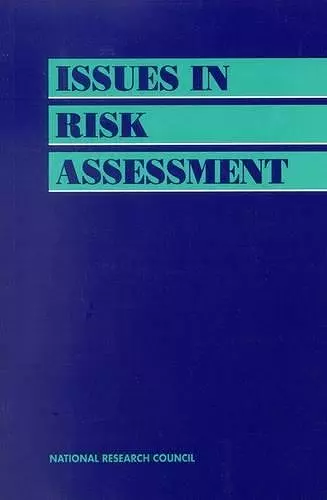Issues in Risk Assessment
National Research Council author Division on Earth and Life Studies author Commission on Life Sciences author Committee on Risk Assessment Methodology author
Format:Paperback
Publisher:National Academies Press
Published:1st Feb '93
Currently unavailable, our supplier has not provided us a restock date

The scientific basis, inference assumptions, regulatory uses, and research needs in risk assessment are considered in this two-part volume.
The first part, Use of Maximum Tolerated Dose in Animal Bioassays for Carcinogenicity, focuses on whether the maximum tolerated dose should continue to be used in carcinogenesis bioassays. The committee considers several options for modifying current bioassay procedures.
The second part, Two-Stage Models of Carcinogenesis, stems from efforts to identify improved means of cancer risk assessment that have resulted in the development of a mathematical dose-response model based on a paradigm for the biologic phenomena thought to be associated with carcinogenesis.
Table of Contents- Front Matter
- Executive Summary
- USE OF THE MAXIMUM TOLERATED DOSE IN ANIMAL BIOASSAYS FOR CARCINOGENICITY
- THE TWO-STAGE MODEL OF CARCINOGENESIS
- A PARADIGM FOR ECOLOGIC RISK ASSESSMENT
- Issues In Risk Assessment Use Of Maximum Tolerated Dose in Animal Bioassays for Carcinogenicity
- BACKGROUND
- SCOPE OF REPORT
- DEFINITIONS AND BACKGROUND
- CORRELATIONS
- RELATIONSHIP BETWEEN TOXICITY AND CARCINOGENICITY OBSERVED AT MTD
- QUALITATIVE INFORMATION
- QUANTITATIVE INFORMATION
- OPTION 1
- OPTION 2
- OPTION 3
- Option 4A
- Option 4B
- 5 Conclusions and Recommendations
- REFERENCES
- BACKGROUND
- DEFINING AND DETERMINING THE MTD
- Appendix B Organizing Subcommittee
- Appendix C Federal Liaison Group
- Appendix D Workshop Program
- Appendix E Workshop Attendees
- 1. INTRODUCTION
- 2.1 Measures of Carcinogenic Potency
- 2.2 Carcinogenic Potency Database (CPDB)
- 2.3 Variation in Carcinogen Potency
- 2.4 Classification of Carcinogens
- 3.1 Empirical Correlations
- 3.2 Range of Possible TD50 Values
- 3.3 Analytical Correlations
- 3.4 Model Dependency
- 3.5 Genotoxic vs. Nongenotoxic Carcinogens
- 4.1 Predictions Based on the MDT
- 4.2 Predictions Based on Mutagenicity and Acute Toxicity
- 5.1 Correlation Between Upper Bounds On the Low Dose Slope and MTD
- 5.2 Correlation Between q1* and the TD50
- 5.3. Preliminary Estimate of Risk
- 6. INTERSPECIES EXTRAPOLATION
- 6.1 Extrapolation from Rats to Mice
- 6.2 Extrapolation from Rodents to Humans
- 7. CONCLUSIONS
- 8. ACKNOWLEDGEMENTS
- 9. REFERENCES
- ANNEX A: MAXIMUM LIKELIHOOD METHODS FOR FITTING THE WEIBULL MODEL
- ANNEX B. SHRINKAGE ESTIMATORS OF THE DISTRIBUTION OF CARCINOGENIC POTENCY
- ANNEX C: ADJUSTMENT OF POTENCY VALUES FOR LESS THAN LIFETIME EXPOSURE
- ANNEX D: CORRELATION BETWEEN TD50 AND MTD
- ANNEX E: CORRELATION BETWEEN TD50S FOR RATS AND MICE
- Appendix G Informal Search for ''Supercarcinogens"
- CRITERIA AND CANDIDATE CHEMICALS
- DATA
- RESULTS
- DISCUSSION
- Issues in Risk Assessment The Two-Stage Model Of Carcinogenesis
- INTRODUCTION
- BIOLOGIC CONSIDERATIONS
- THE TWO-STAGE MODEL
- APPLICATIONS OF THE TWO-STAGE MODEL TO ANIMAL DATA
- Data Needs
- Criteria for Adoption
- Prospects
- CONCLUSIONS AND RECOMMENDATIONS
- REFERENCES
- BIOLOGICAL FACTORS IN TWO-STAGE MODELS
- TWO-STAGE MODEL OF CLONAL EXPANSION
- APPLICATION OF THE TWO-STAGE MODEL TO ANIMAL DATA
- Appendix B Workshop Program
- Appendix C Workshop Federal Liaison Group
- TOPIC GROUP MEMBERS
- Appendix E Workshop Organizing Task Group
- Isuees In Risk Assessment A Paradigm for Ecological Risk Assessment...
ISBN: 9780309047869
Dimensions: unknown
Weight: unknown
374 pages